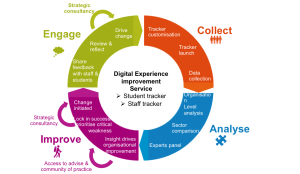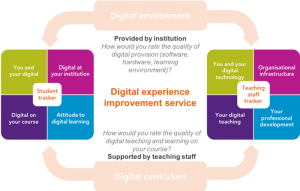We started the new year by talking about a new, ‘360 degree’ approach to understanding and enhancing the student digital experience. Here is a snapshot of our thinking to date.

Over the next few blog posts we’re going to introduce some new members of the tracker family that together make up a virtuous circle of engaging stakeholders, gathering data, and supporting change. Today we’re launching our pilot survey for teaching staff.
The pilot process
- Sign-up form opens today – this is a simple form asking for basic information only and a rationale for why you are interested in the staff project
- Sign-up form closes 5 March. 6 FE and 6 HE institutions are chosen to participate. You will be contacted then with guidance on how to run the pilot project
- Staff trackers close on 31 May. You will be asked to complete a short evaluation form during June to help us improve the staff tracker for service.
Why a teaching staff tracker?
Why are we suggesting that you should survey teaching staff as well as students?
We all know that student surveys have a mixed press at the moment. One reason is that students see data being siphoned off to create a national benchmark, rather than being owned and analysed locally, with their input at every stage. We hope we’re addressing that concern with our guidance on engagement and our data co-ownership model.
Another problem is that teaching staff can feel at the mercy of student opinion, with their own perspective being ignored. Teaching staff have their own experience of the digital environment for teaching and learning. They are key to enabling students’ digital experience, but students may not know what constraints and opportunities they have. For these reasons we see teaching staff as providing essential piece of the overall picture.
This diagram from Tabetha explains how the two surveys are connected. We ask students to rate the quality of digital provision (the digital environment provided by the organisation) and the quality of the digital learning and teaching experience. We ask staff to rate the same digital provision from their perspective. We also ask them about how they are supported, especially through professional development, to provide a high quality digital teaching and learning experience to students.

We follow this up with guidance on analysing the data from the staff tracker, and making sense of it either separately or alongside your student data. (Don’t forget that there is now updated guidance to analysing your staff tracker data, if you are at that stage in the process.)
In future we imagine that organisations might want to run staff and student trackers alternately, both together, or just focus on one or the other instrument as suits their needs. There are two key metrics in each survey for tracking and benchmarking.
What questions are teaching staff asked?
We’ve blogged before about how we arrived at our questions for teaching staff and over the past few weeks we have been working with some experts to arrive at a final set for piloting. In the next post we’ll give you access to all the questions along with the micro-survey version.
The questions are mapped both to the questions for students and to the questions for organisations. This allows you, as an institution, to explore some of the same issues from three different perspectives.
What is involved in the pilot?
If you see the value of engaging with teaching staff – and especially if you are one of the institutions that requested a staff version (see how we look after you!) – just complete the sign-up form here. The process will be very similar to the student tracker, which is why to begin with we are only opening up the pilot to existing tracker institutions. You will have access to a master tracker from which you copy, customise and launch your own version. There will be some lightweight additional guidance.
For this pilot we are asking all participants to distribute the link to their staff via the BOS email system (so that we all have access to the response rate data). If you haven’t used this system before then don’t worry, we will give you support. You can then if you wish then use the same system for any future runs of the student tracker. You will be asked some evaluation questions – as usual – so that we can make further improvements.
The timescale for this pilot is short to allow us to analyse the findings alongside the student tracker. We are not expecting you to engage large numbers of staff – this is a first run to find out how the staff tracker can best be used and to help us make any necessary improvements. We hope involvement in the pilot will give you an opportunity of engaging with teaching staff about the tracker – perhaps in a way that makes it easier through them to engage with students?
What next?
At the start of march we’ll launch a landing page for teaching staff interested in the tracker. This is particularly important for staff pilot institutions, but it’s also a place that all pilots can send teaching staff for information (and hopefully reassurance) about the project.
In coming posts we’ll be telling you about our new ‘micro’ versions of the staff and student surveys, with some quick guides for those wanting to collect a smaller amount of data more easily. And we’ll be launching ‘360 degrees’ guidance to help you use both surveys, along with your organisational data (remember those 10 questions on the confirmation form?) to really understand your institution in the round and create the best opportunities for change.
Don’t forget that to sign up for the staff tracker pilot you must complete the sign-up form by 5 March at the latest. This is a very simple form – you don’t have to repeat any of the organisational questions we put you through when you signed up to run the student tracker!
